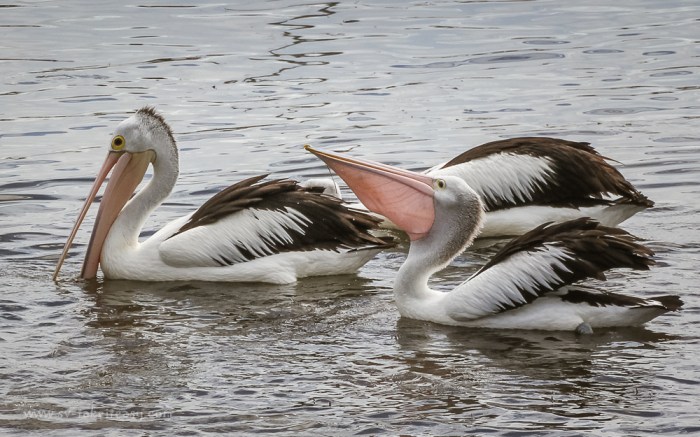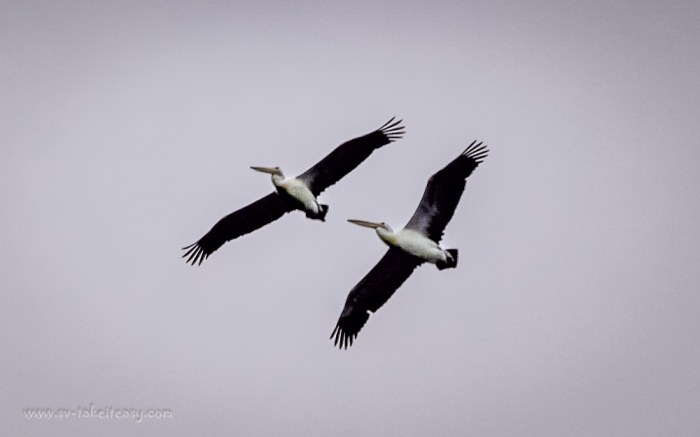Recognised instantly by its massive bill and pouch, the Australian Pelican (Pelicanus conspicillatus) is a common sight around wharves and in coastal towns. Its spectacular soaring high in the sky alternating with skimming flight just above the water never fail to impress us, and we are making it the star of our #41 Bird Photography Challenge.
What does it look like?
 This waterbird is one of seven species of Pelicans in the world. The Australian species is white with black wings and a pink bill. This is a large bird, among the heaviest of flying bird. The Australian Pelican weighs 8 to 10 kilos and its average size is 1.6 to 1.8 m, with a wingspan of up to 2.5 m. It has a long neck, and short legs with fully webbed feet. The tail is short and square.
This waterbird is one of seven species of Pelicans in the world. The Australian species is white with black wings and a pink bill. This is a large bird, among the heaviest of flying bird. The Australian Pelican weighs 8 to 10 kilos and its average size is 1.6 to 1.8 m, with a wingspan of up to 2.5 m. It has a long neck, and short legs with fully webbed feet. The tail is short and square.
One of the most distinctive features of the Pelican is its bill, the longest of any living bird at 50 cm. It has a down-curved hook at the end of the upper mandible, and a huge throat pouch attached to the bottom mandible, which it uses to catch prey, a bit like a net. The bill is highly sensitive, which helps locate fish. Pelicans can be seen snapping around the prey when they sense movement. “Funny bird the pelican, its beak can hold more than its belly can” was a little ditty I was told when I first arrived in Australia. And it is true: up to 13 litres of water can be scooped up with prey in the enormous pouch, but the water is drained before the pelican swallows its catch.
Did you know?
The Pelican is relatively light for its bulk and remarkably buoyant because of air pockets in its skeleton and beneath the skin in its chest. When you look at it swimming, it floats high in the water.
How does it behave?
The Australian Pelican frequents inland and coastal waters where it feeds mainly on fish, catching them at or near the water surface. But it will also eat crustaceans, frogs and even other birds like silver gulls, and scavenge on scraps left behind by people.
Pelicans are gregarious birds, travelling in flocks, hunting cooperatively and breeding in colonies of several hundred birds. They tend to nest on the ground, roosting along beaches, sandbanks and in shallow water.
 During breeding season the pouch, bill and bare facial skin become brightly coloured. Pelicans go through an extended courtship ritual where males follow a female around. During this time the males swing their open bills to get the female’s attention, fight each other and ripple their throat pouches. One by one the males drop away until only one is left and they mate.
During breeding season the pouch, bill and bare facial skin become brightly coloured. Pelicans go through an extended courtship ritual where males follow a female around. During this time the males swing their open bills to get the female’s attention, fight each other and ripple their throat pouches. One by one the males drop away until only one is left and they mate.
Pelicans are expert flyers. They minimise flapping, instead using thermals for soaring to heights up to 3000 m. They glide effortlessly and fly in V formation to travel distances of up to 150 km to feeding areas. They can also fly low, skimming just a few centimeters above the surface of the water, using a phenomenon known as ground effect to reduce drag and increase lift.

Where is it found?
Australian Pelicans frequent the coast, large waterways, lagoons and lakes. They can also follow inland floodwaters. When Lake Eyre flooded for instance, thousands of Pelicans aggregated in this normally arid region. So they are flexible and adapt to new environments in response to the availability of water resources and food.
We often see Pelicans at the Gippsland Lakes and in fishing towns such as Port Albert and Bermagui, and this is where most of the photos in the gallery were taken.













I love pelicans, have to be one of my favourite birds.
They are quite striking aren’t they!
Amazing bird the pelican,
Its beak can hold more than its belly can!
Yes, you saw that your Dad’s ditty was not forgotten.
We see them every morning, usually resting with a full belly near flocks of sea gulls and terns. Love watching their landings and thermalling ….. such a regal bird! Great pics Chris!
Yes we love them flying a few centimetres from the water surface!
Spectacular shots, Chris, of an impressive and distinctive bird. I’ve seen pelicans flying a few times, but have not yet seen one up close.
They are common here but impressive nonetheless. I love their nearly sculptural head and of course the ground effect as they come in to land over water is amazing. Thanks for commenting Mike.
Love their eyes and the way they come into land on the water, with their feet down and forward
Hi Sue, yes I particularly like the ground effect, a few centimeters from the water surface. They seem to glide effortlessly for ever!
Love Pelicans! What fun birds! Great photos, per usual 🙂
Thanks guys!